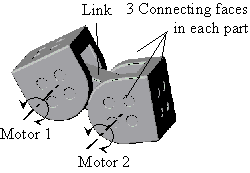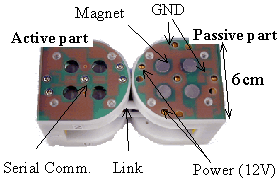Research Description
Contents
The design of a module is as simple as follows but is adequate to make various 3-D structures.

Designed module |

Prototype module (Weight: 400g) |
A module consists of two semi-cylindrical parts which are connected by a link part. Each semi-cylindrical part can rotate 180 degrees (Motion picture of an experiment mpeg: 2.6MB, Realmedia: 1MB).
Each semi-cylindrical part has three connection surfaces which can connect to other modules by magnetic force. Magnets in the "active part" is suspended as in the following figure. Firm and accurate connection and rapid disconnection are realized by the mechanism* which consists of nonlinear springs and shape memory alloys (Motion picture of an experiment mpeg: 2.6MB, Realmedia: 1.6MB).
By such simple module design and smart connection mechanism, a small and light weight module is realized and even a dynamical motion of several modules are possible.
Inside structure of module
In addition, electrodes are placed on each connection surface for power supply and communication with the host computer. By the connection of electrodes between modules, only three wires are connected from outside for all the module while huge wires were necessary for most robots.
*Developed based on the idea of "Internally balanced Magnetic Unit" (Advanced Robotics, 1-3, 225/242, 1986, S. Hirose, Tokyo Institute of Technology ).